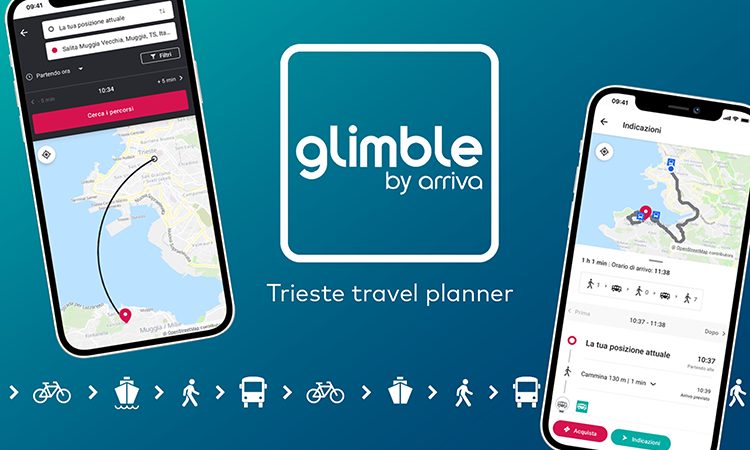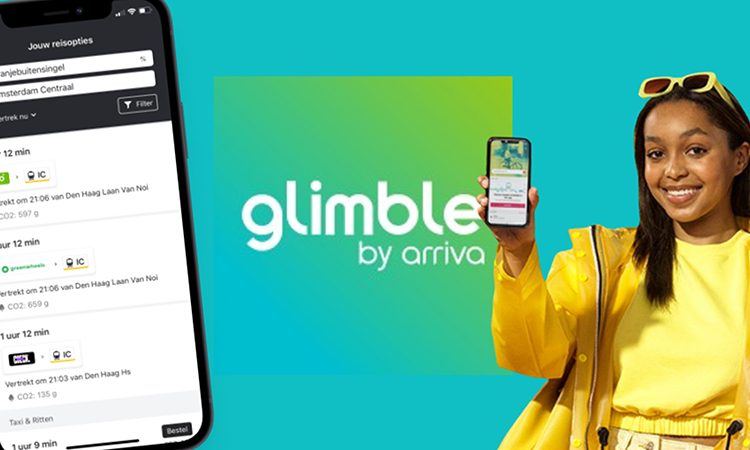Transforming urban mobility across Europe with innovative MaaS solutions
- Like
- Digg
- Del
- Tumblr
- VKontakte
- Buffer
- Love This
- Odnoklassniki
- Meneame
- Blogger
- Amazon
- Yahoo Mail
- Gmail
- AOL
- Newsvine
- HackerNews
- Evernote
- MySpace
- Mail.ru
- Viadeo
- Line
- Comments
- Yummly
- SMS
- Viber
- Telegram
- Subscribe
- Skype
- Facebook Messenger
- Kakao
- LiveJournal
- Yammer
- Edgar
- Fintel
- Mix
- Instapaper
- Copy Link
Posted: 23 January 2024 | Martijn van de Weijer - Arriva Nederland | No comments yet
Martijn van de Weijer, Managing Director, glimble by Arriva, provides insight into glimble’s journey and discusses why Mobility-as-a-Service is the answer to urbanisation as the company looks to create more sustainable cities.


Credit: Arriva Group
The world is becoming increasingly urbanised. According to the United Nations (UN), today, more than half of the global population lives in urban areas, up from around one-third in 1950 and projected to increase to around two-thirds in 2050. Sustainable development depends critically on the successful management of urban growth to create sustainable cities, and one of the obvious components is how we manage our transport systems.
With sprawling urban environments, we need a range of interconnected transport systems that give people the accessibility that they need when moving around cities”
As urban populations increase, we consume more energy and release more pollutants. Air pollution is one of the most serious effects of urbanisation, mainly caused by a high concentration of vehicles and industries.
One of the most important mitigations for the negative impacts of urbanisation is to improve the way that cities are planned and managed. This includes everything from more sustainable infrastructure, better land-use planning and improved transportation systems. Mobility-as-a-Service (MaaS) can support these goals.
With sprawling urban environments, we need a range of interconnected transport systems that give people the accessibility that they need when moving around cities, as well as more efficient ways for people driving into cities to switch to public transport networks. By providing more choice, we are more likely to encourage people to mix their modes of transport. MaaS has an increasingly relevant role to play in modern urban environments, not only providing a service to people as they travel around, but also informing operators, passenger transport authorities and city planners by providing a glimpse into travel patterns and peak time usage so that timetables can be adapted to provide better connections.
Introducing glimble by Arriva
Ultimately, MaaS could offer a shift away from transport being fundamentally a provider-led service, where fixed capacity is provided to cater for a predictable demand, to being a fully user-led system”
Arriva decided to develop the ‘glimble by Arriva‘ brand just over two years ago. Initially launched in the Netherlands in August 2021, it was developed with the potential to roll-out in other parts of Europe where the data sharing policies can support it. In the Netherlands, glimble has over 300,000 users and is now available in over 40 languages. It’s a great example of how we, as a public transport company, can serve our customers with innovative solutions and grow our business beyond our own operations and geographic boundaries.
glimble brings together all public transport options (bus, trains, tram, metro, ferries) alongside shared modes such as bike, car-share, moped/scooter share, plus on-demand taxi services. Users can sort their travel options based on earliest arrival, shortest travel time, least walking, fewest transfers, cheapest route or lowest CO2 emission. They can also filter if they don’t want to use a certain transport mode – for example, exclude cars. In addition, users can set a maximum walking duration and can select a slower walking pace, so that more time is calculated for walking. Users can also access real-time information and avoid parts of the network where there is disruption.
Ultimately, MaaS could offer a shift away from transport fundamentally being a provider-led service, where fixed capacity is provided to cater for a predictable demand, to being a fully user-led system whereby the level and type of transport supply continually adjusts in response to the specific desires of individual travellers. This could offer policymakers and passenger transport authorities a great opportunity.
Arriva has recently launched the glimble brand in the Trieste region of Northern Italy. This is part of our strategy to expand within the MaaS sector. We are now exploring rolling it out to other Italian cities, as well as exploring other European markets. Furthermore, we are developing new innovative ways of using glimble to attract new entrants to the public transport sector who would traditionally complete their journeys by car.


Credit: Arriva Group
The power of MaaS in shaping sustainable travel habits
Interconnected mobility has the potential to make public transport the easy choice”
We think that MaaS can influence small changes in travel patterns, which could make a big difference. For example, recent analysis conducted in the Netherlands looked at the opportunity for growing the usage of existing Park and Ride capacity outside of city centres and determined that switching just 1% of car kilometres to public transport would see public transport use growing by 25% – a compelling business case. Now, the team is building digital capability into the app which alerts motorists of the opportunity to complete their journey faster and cheaper by making use of Park and Ride capacity en route and using local transport to get into the city centre. This type of innovation could be a game changer, because it acknowledges that some people need to use their cars for part of their journey, but it brings new business into the public transport sector by allowing them to switch seamlessly.
Travellers want easy journeys, so being able to seamlessly connect across more than one mode of transport is essential – interconnected mobility has the potential to make public transport the easy choice. Today’s travellers are all about door-to-door convenience and not just about station-to-station, so incorporating the first- and last-mile into journey planning offers a great opportunity to encourage the uptake of shared mobility.
In developing glimble, we worked with journey planning technology provider Moovit, which meant we could launch with confidence. Moovit is an Intel company and positions itself as the leading MaaS solutions provider, having already created the urban mobility app, which serves over one billion people in 3,400 cities across 112 countries, in 45 languages.
MaaS: The key to seamless journeys
Investing in MaaS has been a good decision on a number of fronts. It’s good for consumers, because it makes travelling more seamless and interconnected, with improved service information; it’s good for local authorities, because increasing the use of public transport and shared mobility will help them to reach their reduced emissions targets; it’s obviously good for our towns and cities, creating more pleasurable and less congested environments; and it’s good for our business because it has widened our reach beyond our own operations.
For MaaS to become a reality throughout the whole of Europe, data sharing needs to be facilitated and regulated”
In a world where everyone is constantly on the move and connection and accessibility is essential, we know how important it is to be adaptable and nimble for the communities that we serve. But, for MaaS to become a reality throughout the whole of Europe, data sharing needs to be facilitated and regulated.
In the Netherlands, travel throughout the whole country is possible with glimble and not limited to Arriva’s services, but extends across all operators and all modes, bringing all of the transport options together for fully integrated, multimodal journey planning. We continue to work on a number of developments to further improve glimble’s capability. Every few weeks, we release new functionalities or integrations. We learn through feedback from our customers and, with every new release, the app is evolving and expanding further.
Making glimble accessible for all
We continuously examine how to make the app valuable for the widest possible target group, so that all of society can choose the most sustainable way to travel”
Our glimble app currently has some good accessibility features, such as screen reading for low vision users, talkback and voiceover capabilities. The app can identify wheelchair-accessible routes and stations, while also calculating step-free journeys. For those with hand-motor disabilities, glimble is designed with optimised menus and buttons. Other functionalities due to be added to the app include parking locations and a search capability for electric car charging points.
As a public transport company, we stand for inclusiveness and believe that it is important for all forms of mobility to be accessible. We continuously examine how to make the app valuable for the widest possible target group, so that all of society can choose the most sustainable way to travel. We’ve worked hard to make the app user-friendly.
MaaS certainly has a role to play in advancing the use of public transport and helping to decarbonise the way that we travel. For Arriva, glimble is a great example of how we, as a public transport company, can serve our customers with innovative solutions that make their everyday travel experience easier. It has also demonstrated how our business can evolve and grow beyond the boundaries of our own operations and geographic boundaries.
With buses, trains, coaches, trams, waterbuses, bike-sharing systems and on-demand transport solutions, Arriva connects people and communities every day in the Czech Republic, Croatia, Hungary, Italy, the Netherlands, Poland, Slovakia, Slovenia, Spain and the UK.
In 2021, Arriva first launched its ‘glimble by Arriva’ MaaS solution in the Netherlands and it has been on a growth trajectory ever since, with over 300,000 users today. glimble by Arriva has recently entered a second European market, having launched in Italy in November 2023.


Related topics
Accessibility, Mobility Services, Modal shift, Multimodality, Passenger Experience, Public Transport, Sustainable Urban Transport
Related modes
Bikes & Scooters, Bus & Coach, Rail
Related countries
Croatia, Czech Republic, Hungary, Italy, Poland, Slovakia, Slovenia, Spain, The Netherlands, United Kingdom
Related organisations
Arriva Group, Arriva Netherlands
Related people
Martijn van de Weijer







